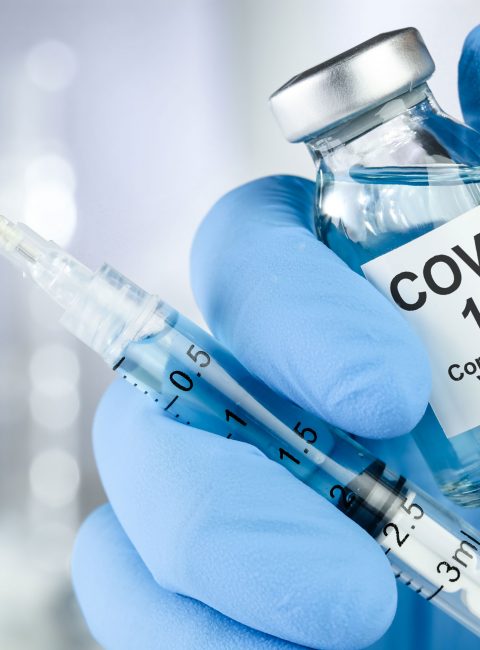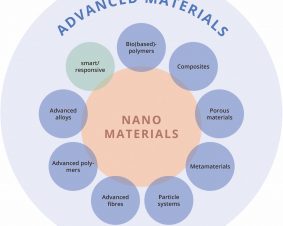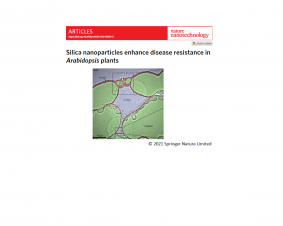 >
Spotlight February 2021: Nanoobjects in the COVID-vaccine – scientifically correct?
>
Spotlight February 2021: Nanoobjects in the COVID-vaccine – scientifically correct?
The COVID-19 pandemic induces very different reactions of people on the internet (https://www.cdc.gov/mmwr/volumes/70/wr/mm7002e1.htm) and in the social networks. Without following the conspiracy theories as “5G nanochip hidden in COVID vaccines” some news as “COVID vaccines induce allergic reactions” should be scientifically recognised. The picture from the 5G-nanochip whose plan goes viral on the internet is now exposed as fake and shows a guitar pedal. Quite different the recent news about allergic responses after injection of the COVID vaccine [1-3]. Is it true, and how about nanoparticles in vaccines?
Firstly, we should know that the active ingredient within the new vaccines are very sensitive molecules (the so-called mRNA) which must not only be cooled during transport but also would immediately be degraded after injection if not explicitly be stabilized by a special nano-shell. Here the principles of nanomedicine are adopted as the instable RNA-molecule is packed into a lipid layer containing stabilizing polymers (e.g. polyethylene glycol = PEG and others) [4, 5]. These polymers are part of the transport system which delivers the active agent to the cells in our body which start the anti-viral machinery. Unfortunately, such molecules may have a disadvantage because a small part of the population responds sensitive to polymers such as PEG which has been observed in 12 patients after getting the vaccine [1, 3]. The portion of sensitive people is very small but not negligible (currently more than 32 Mio. people have been vasccinated, as of January 2021), thus, it is important to know about the ingredients [please find the full list of the two recent vaccines in 3] and to discuss these with the treating physician. Scientific fact is: the size of the lipid vesicles (nano) is not of importance in relation to adverse effects. Ingredients such as the polymers of the shell around the active agent may induce problems, but the advantage of a COVID vaccination is indisputable.
If someone wants to know more about nanoparticles and vaccination, please visit the website of the Helmholtz Centre for Infection Research: https://www.helmholtz-hzi.de/en/news-events/stories/vaccination-with-nanoparticles/ .
Literature:
- de Vrieze, J (2021) Pfizer’s vaccine raises allergy concerns. Science, 371(6524): 10-11.
- Kleine-Tebbe, J et al. (2021) Severe allergic reactions to the COVID-19 vaccine – statement and practical consequences. Allergol Select, 5 26-28.
- Worm, M et al. (2021) Covid-19 vaccination and risk of anaphylaxis – Recommendations for practical management. MMW Fortschr Med, 163(1): 48-51.
- Editorial (2020) Nanomedicine and the COVID-19 vaccines. Nat Nanotechnol, 15(12): 963
- Abd Ellah, NH et al. (2020) Nanomedicine as a promising approach for diagnosis, treatment and prophylaxis against COVID-19. Nanomedicine (Lond), 15(21): 2085-2102.

Weitere Spotlights
Spotlight June 2022: From small to clever – What does the future hold for the safety and sustainability of advanced materials?
The smallest particles in materials research, nanoparticles, have occupied us intensively for more than 20 years to elucidate and further investigate their safety for humans and the environment. Now, however, the development is going from “small = nano” to “clever = advanced”, as discussed in a contribution by international scientists. Thereby, it is a great […]
Read moreSpotlight December 2022: Fighting tumors with micro robots
When we, the DaNa team as operators of the website nanopartikel.info, write about nanobots, i.e. nanometre-sized machines, we point out that these machines belong to science fiction, may even remain a utopia – i.e. never realisable. On the significantly larger micro-scale, however, small machines are conceivable that could help in the therapy of diseases, e.g. […]
Read moreSpotlight November 2022: Photonics in nature and bioinspired designs
Science has always taken nature as a model and imitated it. If you look at the field of photonics, i.e. the use of optical technologies for information processing, transmission or storage, the colorful examples in the animal and plant world are perfect basic drawers for technical applications. While colors in nature are used either for […]
Read moreSpotlight December 2021: Silica nanoparticles improve plant disease resistance
The resistance of plants to various pathogens is often increased in agriculture with various chemicals (“fertilizers”). A new direction is being taken with the use of nanoparticles. These can be sprayed on the plants. In the present study, the model plant Arabidopsis was used to investigate whether silicon dioxide nanoparticles (SiO2) can increase resistance to […]
Read more


